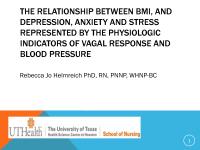Hemoglobin F impacts physiologic variables and perinatal events
View File(s)
- Author(s)
- Details
-
Rebecca Jo Helmreich, PhD, RN, PNNP, WHNP-BC
Visitor Statistics
Visits vs Downloads
Visitors - World Map
Top Visiting Countries
| Country | Visits |
|---|
Top Visiting Cities
| City | Visits |
|---|
Visits (last 6 months)
Downloads (last 6 months)
Popular Works for Helmreich, Rebecca Jo by View
| Title | Page Views |
|---|
Popular Works for Helmreich, Rebecca Jo by Download
| Title | Downloads |
|---|
View Citations
Citations
Objectives: The objectives were 1) to explore the effect of hemoglobin F with obesity and gestational weight gain on heart period, respiratory sinus arrhythmia, oxy-hemoglobin, peripheral oxygenation, hemoglobin A1c , and systolic blood pressure, and 2) to determine if an association exists between the level of HbF and the frequency of perinatal events in low risk pregnant woman with varied body mass index (obese and not-obese).
Methods: An observational study of 41 pregnant women at three time points: 20, 28, and 36 weeks gestation. Data were organized according to the mean HbF level at 20 weeks gestation, with obesity (obese and non-obese), and gestational weight gain (using the Institute of Medicine's recommendation for weight gain). Repeated measures data were analyzed by the general linear model (GLM) to test for group differences and changes over time. Odds ratios were computed to compare the frequency of perinatal outcomes.
Results: There were significant changes in time for HP, RSA, and HbO2. Overall, HbO2 and SBP levels were higher and HP and RSA were lower in the obese women with the lower mean HbF category. Moreover, changes in time of HbO2 were different in obese and non-obese groups. Obese women with the lower mean HbF level had more frequent episodes of diabetes, wound dehiscence and giving birth by cesarean section or assistance with forceps or vacuum extraction. Non-obese women with lower mean HbF levels had postpartal bleeding.
Conclusion: The findings suggest that the pattern of change of HbF during pregnancy may be different for obese and non-obese women. However, further research is needed before HbF levels can be used as a marker for altered adaptation in pregnancy.
41st Biennial Convention - 29 October-2 November 2011. Theme: People and Knowledge: Connecting for Global Health. Held at the Gaylord Texan Resort & convention Center.
Items submitted to a conference/event were evaluated/peer-reviewed at the time of abstract submission to the event. No other peer-review was provided prior to submission to the Henderson Repository, unless otherwise noted.
| Type | Presentation |
| Acquisition | Proxy-submission |
| Review Type | Abstract Review Only: Reviewed by Event Host |
| Format | Text-based Document |
| Evidence Level | Observational |
| Research Approach | N/A |
| Keywords | Vagal Response; Hemoglobin F; Adaptation to Pregnancy |
| Name | 41st Biennial Convention: People and Knowledge: Connecting for Global Health |
| Host | Sigma Theta Tau International |
| Location | Grapevine, Texas, USA |
| Date | 2011 |
All rights reserved by the author(s) and/or publisher(s) listed in this item record unless relinquished in whole or part by a rights notation or a Creative Commons License present in this item record.
All permission requests should be directed accordingly and not to the Sigma Repository.
All submitting authors or publishers have affirmed that when using material in their work where they do not own copyright, they have obtained permission of the copyright holder prior to submission and the rights holder has been acknowledged as necessary.
Related items
Showing items related by title, author, creator and subjects.
-
The relationship between BMI, and depression, anxiety and stress represented by the physiologic indicators of vagal response and blood pressure
Helmreich, Rebecca Jo (2016-03-17)Purpose: The purpose of this study was to determine the relationship between body mass index (BMI), and depression, anxiety and stress represented by the physiologic indicators of vagal response and blood pressure. Depression, ... -
Impact of hemoglobin A1c screening program among medicare patients
Quinn, Mary Jo; Schaffer, SusanIn 2016, HouseCalls began conducting point-of-care hemoglobin A1c screening as part of an annual preventative home visit program for patients covered under one Medicare Advantage health plan. This retrospective study (n = ... -
Variables associated with the response of health care professionals to a public health event (PHE)
Connor, B. Susan (2012-01-04)Whether or not healthcare professionals respond to a public health event (PHE) is a vital concern for a community. Although response rates, abilities and willingness to respond have been the focus of numerous research ... -
Sociocultural, physiologic, and psychologic variables that influence pain in the fibromyalgia patient
Hughes, Linda CarolIt is estimated that fibromyalgia, a chronic condition in which pain occurs in 98% of the patients, can be found in 3- to 6-million American adults with females as the majority of those suffering. The purpose of this study ... -
How does interventions performed in the ICU modify physiological variables in neurocritical patients?
Ortega-Perez, Stefany; Rey, Maria Consuelo AmayaThe main goal of the care of neurocritical patients is the prevention of secondary brain injury (SBI). However, some interventions performed by the healthcare team can stimulate the patient and lead to conditions that cause SBI.





